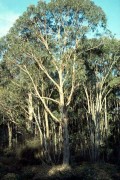 Loading... Please wait...
Loading... Please wait...
Our Products
Join our newsletter
Eucalyptus Globulus Bicostata
Price:
$110.00
(including GST)
Common Name:
EURABBIE
PLEASE NOTE: Orders are by full tray only. Each tray contains 40 plants. When ordering, please choose how many trays you would like.
WHAT IT LOOKS LIKE:
- Tall tree to 40m high with smooth white or grey bark, shedding in ribbons, and long narrow glossy green adult leaves.
- Flowering white-cream from September to January.
- Leaves produce orange-tan dye with mordant alum.
- Strong, moderately durable, with light-yellow or brown heartwood. Usually has interlocked grain with distinct growth rings.
WHERE IT GROWS & WHY:
-
Widespread, in most catchments and districts on the drier hills and slopes.Grassy woodlands on various soils. Commonly moderately fertile soils.Compact loams, below 800m elevation.Tolerates frost, winter waterlogging and drought.Primarily in wetter areas east of Hume Highway and south of Murrumbidgee catchments.
- Moist, relatively heavy, fertile soil. Tolerates poorly-drained and boggy soil.
- Grows very rapidly when young. Uses large volumes of water, and if grown outside its natural range, summer water shortages may lead to tree death. Responds to fertiliser.
- Seedlings are susceptible to frost.
MANAGEMENT/SIGNIFICANCE:
- Useful high-level cover in windbreaks. Casts heavy shade which suppresses most other vegetation.
- Useful in gully erosion control, behind fibrous-rooted understorey plants.
- Forms good coals and few sparks. Rates fair in splitting and ignitability.
- Can be grown for hardwood pulp or sawlogs.
- Useful as quick-growing "nurse" crop for Acacia Melanoxylon - Blackwood - which benefits from shelter.
- Nectar-rich flowers food for various insects and nectar-feeding birds. Fruit and seeds eaten by lorikeets, parrots and rosellas. Foliage important koala food. Hollows nesting sites for many birds and mammals. Important food source for the Yellow-bellied Glider.
- Useful in parklands where a dense stand required quickly. Generally unsuitable for smaller gardens. Sometimes seen as untidy because its fallen leaves and twigs are slow to decompose. Suppresses most other vegetation.
- Leaves were used in a range of treatments including croup, asthma and colds as a vapour inhalation, and as an insecticide powder or spray.
Image Source: Crisp, M. via Australian National Botanic Gardens (ANBG)
- Home
- Eucalyptus Trees
- Eucalyptus Globulus Bicostata
